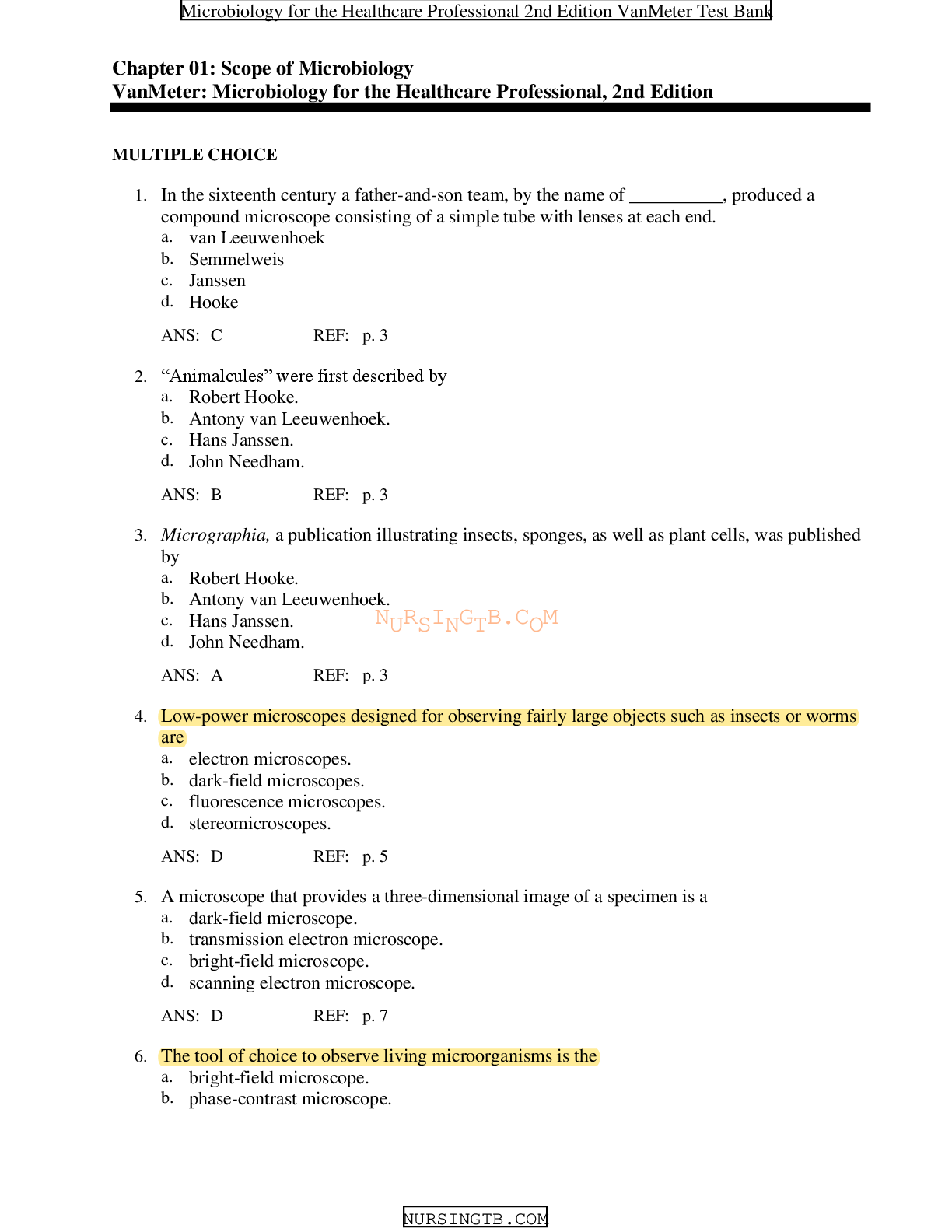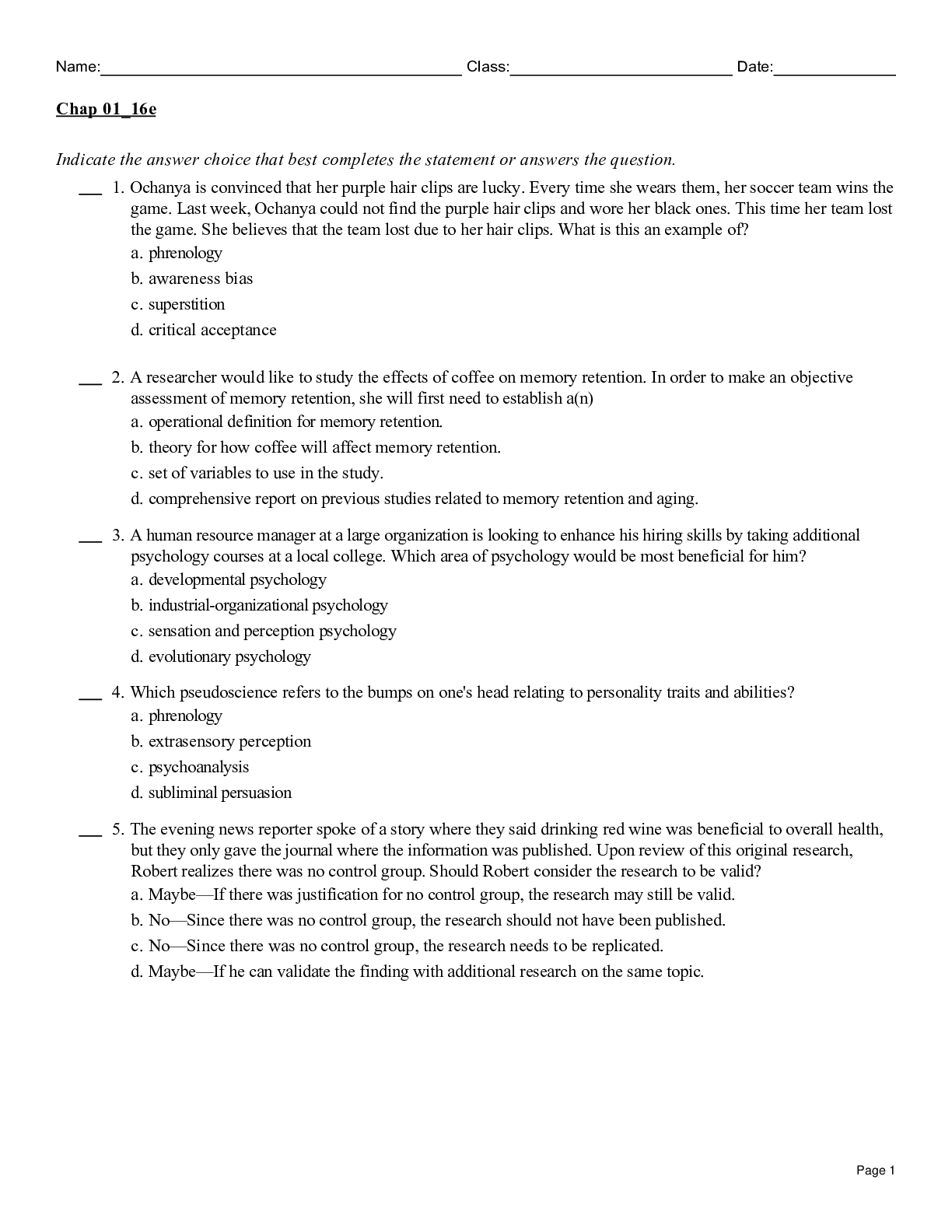Engineering > TEST BANKS > Elementary Surveying An Introduction to Geomatics, 16th edition By Charles D. Ghilani (Test Bank ) (All)
Elementary Surveying An Introduction to Geomatics, 16th edition By Charles D. Ghilani (Test Bank )
Document Content and Description Below
Table of Contents Introduction 1.1 Definition of Surveying 1.2 Geomatics 1.3 History of Surveying 1.4 Geodetic and Plane Surveys 1.5 Importance of Surveying 1.6 Specialized Types of Surveys 1. ... 7 Surveying Safety 1.8 Land and Geographic Information Systems 1.9 Federal Surveying and Mapping Agencies 1.10 The Surveying Profession 1.11 Professional Surveying Organizations 1.12 Surveying on the Internet 1.13 Future Challenges in Surveying Units, Significant Figures, and Field Notes Part I: Units and Significant Figures 2.1 Introduction 2.2 Units of Measurement 2.3 International System of Units (SI) 2.4 Significant Figures 2.5 Rounding Off Numbers Part II: Field Notes 2.6 Field Notes 2.7 General Requirements of Handwritten Field Notes 2.8 Types of Field Books 2.9 Kinds of Notes 2.10 Arrangements of Notes 2.11 Suggestions for Recording Notes 2.12 Introduction to Survey Controllers 2.13 Transfer of Files from Survey Controllers 2.14 Digital Data File Management 2.15 Advantages and Disadvantages of Survey Controllers Theory of Errors in Observations 3.1 Introduction 3.2 Direct and Indirect Observations 3.3 Errors in Measurements 3.4 Mistakes 3.5 Sources of Errors in Making Observations 3.6 Types of Errors 3.7 Precision and Accuracy 3.8 Eliminating Mistakes and Systematic Errors 3.9 Probability 3.10 Most Probable Value 3.11 Residuals 3.12 Occurrence of Random Errors 3.13 General Laws of Probability 3.14 Measures of Precision 3.15 Interpretation of Standard Deviation 3.16 The 50%, 90%, and 95% Errors 3.17 Error Propagation 3.18 Applications 3.19 Conditional Adjustment of Observations 3.20 Weights of Observations 3.21 Least-Squares Adjustment Leveling — Theory, Methods, and Equipment Part I: Leveling — Theory and Methods 4.1 Introduction 4.2 Definitions 4.3 North American Vertical Datum 4.4 Curvature and Refraction 4.5 Methods for Determining Differences in Elevation Part II: Equipment for Differential Leveling 4.6 Categories of Levels 4.7 Telescopes 4.8 Level Vials 4.9 Tilting Levels 4.10 Automatic Levels 4.11 Digital Levels 4.12 Tripods 4.13 Hand Levels 4.14 Level Rods 4.15 Turning Points 4.16 Testing and Adjusting Levels Leveling — Field Procedures and Computations 5.1 Introduction 5.2 Carrying and Setting Up a Level 5.3 Duties of a Rod Person 5.4 Differential Leveling 5.5 Precision 5.6 Adjustments of Simple Level Circuits 5.7 Reciprocal Leveling 5.8 Three-Wire Leveling 5.9 Profile Leveling 5.10 Grid, Cross-Section, or Borrow-Pit Leveling 5.11 Use of the Hand Level 5.12 Sources of Error in Leveling 5.13 Mistakes 5.14 Reducing Errors and Eliminating Mistakes 5.15 Using Software Distance Measurement Part I: Methods for Measuring Distances 6.1 Introduction 6.2 Summary of Methods for Making Linear Measurements 6.3 Pacing 6.4 Odometer Readings 6.5 Optical Rangefinders 6.6 Tacheometry 6.7 Subtense Bar Part II: Distance Measurements by Taping 6.8 Introduction to Taping 6.9 Taping Equipment and Accessories 6.10 Care of Taping Equipment 6.11 Taping on Level Ground 6.12 Horizontal Measurements on Sloping Ground 6.13 Slope Measurements 6.14 Sources of Error in Taping Part III: Electronic Distance Measurement 6.15 Introduction 6.16 Propagation of Electromagnetic Energy 6.17 Principles of Electronic Distance Measurement 6.18 Electro-Optical Instruments 6.19 Total Station Instruments 6.20 EDM Instruments Without Reflectors 6.21 Computing Horizontal Lengths from Slope Distances 6.22 Errors in Electronic Distance Measurement 6.23 Using Software Angles, Azimuths, and Bearings 7.1 Introduction 7.2 Units of Angle Measurement 7.3 Kinds of Horizontal Angles 7.4 Direction of a Line 7.5 Azimuths 7.6 Bearings 7.7 Comparison of Azimuths and Bearings 7.8 Computing Azimuths 7.9 Computing Bearings 7.10 The Compass and the Earth's Magnetic Field 7.11 Magnetic Declination 7.12 Variations in Magnetic Declination 7.13 Software for Determining Magnetic Declination 7.14 Local Attraction 7.15 Typical Magnetic Declination Problems 7.16 Mistakes Total Station Instruments; Angle Observations PART I: Total Station Instruments 8.1 Introduction 8.2 Characteristics of Total Station Instruments 8.3 Functions Performed by Total Station Instruments 8.4 Parts of a Total Station Instrument 8.5 Handling and Setting up a Total Station Instrument 8.6 Servo-Driven and Remotely Operated Total Station Instruments PART II: Angle Observations 8.7 Relationship of Angles and Distances 8.8 Observing Horizontal Angles with Total Station Instruments 8.9 Observing Multiple Horizontal Angles by the Direction Method 8.10 Closing the Horizon 8.11 Observing Deflection Angles 8.12 Observing Azimuths 8.13 Observing Vertical Angles 8.14 Sights and Marks 8.15 Prolonging a Straight Line 8.16 Balancing-in 8.17 Random Traverse 8.18 Total Stations for Determining Elevation Differences 8.19 Adjustment of Total Station Instruments and their Accessories 8.20 Sources of Error in Total Station Work 8.21 Propagation of Random Errors in Angle Observations 8.22 Mistakes Traversing 9.1 Introduction 9.2 Observation of Traverse Angles or Directions 9.3 Observation of Traverse Lengths 9.4 Selection of Traverse Stations 9.5 Referencing Traverse Stations 9.6 Traverse Field Notes 9.7 Angle Misclosure 9.8 Traversing with Total Station Instruments 9.9 Radial Traversing 9.10 Sources of Error in Traversing 9.11 Mistakes in Traversing Traverse Computations 10.1 Introduction 10.2 Balancing Angles 10.3 Computation of Preliminary Azimuths or Bearings 10.4 Departures and Latitudes 10.5 Departure and Latitude Closure Conditions 10.6 Traverse Linear Misclosure and Relative Precision 10.7 Traverse Adjustment 10.8 Rectangular Coordinates 10.9 Alternative Methods for Making Traverse Computations 10.10 Inversing 10.11 Computing Final Adjusted Traverse Lengths and Directions 10.12 Coordinate Computations in Boundary Surveys 10.13 Use of Open Traverses 10.14 State Plane Coordinate Systems 10.15 Traverse Computations using Computers 10.16 Locating Blunders in Traverse Observations 10.17 Mistakes in Traverse Computations Coordinate Geometry in Surveying Calculations 11.1 Introduction 11.2 Coordinate Forms of Equations for Lines and Circles 11.3 Perpendicular Distance from a Point to a Line 11.4 Intersection of Two Lines, Both Having Known Directions 11.5 Intersection of a Line with a Circle 11.6 Intersection of Two Circles 11.7 Three-Point Resection 11.8 Two-Dimensional Conformal Coordinate Transformation 11.9 Inaccessible Point Problem 11.10 Three-Dimensional Two-Point Resection 11.11 Software Area 12.1 Introduction 12.2 Methods of Measuring Area 12.3 Area by Division into Simple Figures 12.4 Area by Offsets from Straight Lines 12.5 Area by Coordinates 12.6 Area by Double-Meridian Distance Method 12.7 Area of Parcels with Circular Boundaries 12.8 Partitioning of Lands 12.9 Area by Measurements from Maps 12.10 Software 12.11 Sources of Error in Determining Areas 12.12 Mistakes in Determining Areas Global Navigation Satellite Systems — Introduction and Principles of Operation 13.1 Introduction 13.2 Overview of GPS 13.3 The GPS Signal 13.4 Reference Coordinate Systems 13.5 Fundamentals of Satellite Positioning 13.6 Errors in Observations 13.7 Differential Positioning 13.8 Kinematic Methods 13.9 Relative Positioning 13.10 Other Satellite Navigation Systems 13.11 The Future Global Navigation Satellite Systems — Static Surveys 14.1 Introduction 14.2 Field Procedures in Static GNSS Surveys 14.3 Planning Satellite Surveys 14.4 Performing Static Surveys 14.5 Data Processing and Analysis 14.6 Things to Consider 14.7 A Method for Obtaining Orthometric Height Differences Using GNSS 14.8 Sources of Errors in Satellite Surveys 14.9 Mistakes in Satellite Surveys Global Navigation Satellite Systems — Kinematic Surveys 15.1 Introduction 15.2 Planning of Kinematic Surveys 15.3 Initialization Techniques 15.4 Equipment Used in Kinematic Surveys 15.5 Methods Used in Kinematic Surveys 15.6 Performing Post-Processed Kinematic Surveys 15.7 Communication in Real-Time Kinematic Surveys 15.8 Real-Time Networks 15.9 Performing Real-Time Kinematic Surveys 15.10 Machine Guidance and Control 15.11 Errors in Kinematic Surveys 15.12 Mistakes in Kinematic Surveys Adjustments by Least Squares 16.1 Introduction 16.2 Fundamental Condition of Least Squares 16.3 Least-Squares Adjustment by the Observation Equation Method 16.4 Matrix Methods in Least-Squares Adjustment 16.5 Matrix Equations for Precisions of Adjusted Quantities 16.6 Least-Squares Adjustment of Leveling Circuits 16.7 Propagation of Errors 16.8 Least-Squares Adjustment of GNSS Baseline Vectors 16.9 Least-Squares Adjustment of Conventional Horizontal Plane Surveys 16.10 The Error Ellipse 16.11 Adjustment Procedures 16.12 Other Measures of Precision for Horizontal Stations 16.13 Software 16.14 Conclusions Mapping Surveys 17.1 Introduction 17.2 Basic Methods for Performing Mapping Surveys 17.3 Map Scale 17.4 Control for Mapping Surveys 17.5 Contours 17.6 Characteristics of Contours 17.7 Method of Locating Contours 17.8 Digital Elevation Models and Automated Contouring Systems 17.9 Basic Field Methods for Locating Topographic Details 17.10 Planning a Laser-Scanning Survey 17.11 Three-Dimensional Conformal Coordinate Transformation 17.12 Selection of Field Method 17.13 Working with Survey Controllers and Field-to-Finish Software 17.14 Hydrographic Surveys 17.15 Sources of Error in Mapping Surveys 17.16 Mistakes in Mapping Surveys Mapping 18.1 Introduction 18.2 Availability of Maps and Related Information 18.3 National Mapping Program 18.4 Accuracy Standards for Mapping 18.5 Manual and Computer-Aided Drafting Procedures 18.6 Map Design 18.7 Map Layout 18.8 Basic Map Plotting Procedures 18.9 Contour Interval 18.10 Plotting Contours 18.11 Lettering 18.12 Cartographic Map Elements 18.13 Drafting Materials 18.14 Automated Mapping and Computer-Aided Drafting Systems 18.15 Migrating Maps between Software Packages 18.16 Impacts of Modern Land and Geographic Information Systems on Mapping 18.17 The Importance of Metadata 18.18 Sources of Error in Mapping 18.19 Mistakes in Mapping Control Surveys and GeodetIc Reductions 19.1 Introduction 19.2 The Ellipsoid and Geoid 19.3 The Conventional Terrestrial Pole 19.4 Geodetic Position and Ellipsoidal Radii of Curvature 19.5 Geoid Undulation and Deflection of the Vertical 19.6 U.S. Reference Frames 19.7 Transforming Coordinates Between Reference Frames 19.8 Accuracy Standards and Specifications for Control Surveys 19.9 The National Spatial Reference System 19.10 Hierarchy of the National Horizontal Control Network 19.11 Hierarchy of the National Vertical Control Network 19.12 Control Point Descriptions 19.13 Field Procedures for Conventional Horizontal Control Surveys 19.14 Field Procedures for Vertical-Control Surveys 19.15 Reduction of Field Observations to their Geodetic Values 19.16 Geodetic Position Computations 19.17 The Local Geodetic Coordinate System 19.18 Three-Dimensional Coordinate Computations 19.19 Software State Plane Coordinates and Other Map Projections 20.1 Introduction 20.2 Projections Used in State Plane Coordinate Systems 20.3 Lambert Conformal Conic Projection 20.4 Transverse Mercator Projection 20.5 State Plane Coordinates in NAD 27 and NAD 83 20.6 Computing SPCS 83 Coordinates in the Lambert Conformal Conic System 20.7 Computing SPCS 83 Coordinates in the Transverse Mercator System 20.8 Reduction of Distances and Angles to State Plane Coordinate Grids 20.9 Computing State Plane Coordinates of Traverse Stations 20.10 Surveys Extending from One Zone to Another 20.11 The Universal Transverse Mercator Projection 20.12 Other Map Projections 20.13 Ground Versus Grid Problem 20.14 Proposed Changes to SPCS in 2022 20.15 Map Projection Software Boundary Surveys 21.1 Introduction 21.2 Categories of Land Surveys 21.3 Historical Perspectives 21.4 Property Description by Metes and Bounds 21.5 Property Description by Block-and-Lot System 21.6 Property Description by Coordinates 21.7 Retracement Surveys 21.8 Subdivision Surveys 21.9 Partitioning Land 21.10 Registration of Title 21.11 Adverse Possession and Easements 21.12 Condominium Surveys 21.13 Geographic and Land Information Systems 21.14 Sources of Error in Boundary Surveys 21.15 Mistakes Surveys of the Public Lands 22.1 Introduction 22.2 Instructions for Surveys of the Public Lands 22.3 Initial Point 22.4 Principal Meridian 22.5 Baseline 22.6 Standard Parallels (Correction Lines) 22.7 Guide Meridians 22.8 Township Exteriors, Meridional (Range) Lines, and Latitudinal (Township) Lines 22.9 Designation of Townships 22.10 Subdivision of a Quadrangle into Townships 22.11 Subdivision of a Township into Sections 22.12 Subdivision of Sections 22.13 Fractional Sections 22.14 Notes 22.15 Outline of Subdivision Steps 22.16 Marking Corners 22.17 Witness Corners 22.18 Meander Corners 22.19 Lost and Obliterated Corners 22.20 Accuracy of Public Land Surveys 22.21 Descriptions by Township Section, and Smaller Subdivision 22.22 BLM Land Information System 22.23 Sources of Error 22.24 Mistakes Construction Surveys 23.1 Introduction 23.2 Specialized Equipment for Construction Surveys 23.3 Horizontal and Vertical Control 23.4 Staking Out a Pipeline 23.5 Staking Pipeline Grades 23.6 Computing the Bend Angles in Pipelines 23.7 Staking Out a Building 23.8 Staking Out Highways 23.9 Other Construction Surveys 23.10 Construction Surveys Using Total Station Instruments 23.11 Construction Surveys Using GNSS Equipment 23.12 Machine Guidance and Control 23.13 As-built Surveys with Laser Scanning 23.14 Sources of Error in Construction Surveys 23.15 Mistakes Horizontal Curves 24.1 Introduction 24.2 Degree of Circular Curve 24.3 Definitions and Derivation of Circular Curve Formulas 24.4 Circular Curve Stationing 24.5 General Procedure of Circular Curve Layout by Deflection Angles 24.6 Computing Deflection Angles and Chords 24.7 Notes for Circular Curve Layout by Deflection Angles and Incremental Chords 24.8 Detailed Procedures for Circular Curve Layout by Deflection Angles and Incremental Chords 24.9 Setups on Curve 24.10 Metric Circular Curves by Deflection Angles and Incremental Chords 24.11 Circular Curve Layout by Deflection Angles and Total Chords 24.12 Computation of Coordinates on a Circular Curve 24.13 Circular Curve Layout by Coordinates 24.14 Curve Stakeout Using GNSS Receivers and Robotic Total Stations 24.15 Circular Curve Layout by Offsets 24.16 Special Circular Curve Problems 24.17 Compound and Reverse Curves 24.18 Sight Distance on Horizontal Curves 24.19 Spirals 24.20 Computation of “As-Built” Circular Alignments 24.21 Sources of Error in Laying Out Circular Curves 24.22 Mistakes Vertical Curves 25.1 Introduction 25.2 General Equation of a Vertical Parabolic Curve 25.3 Equation of an Equal Tangent Vertical Parabolic Curve 25.4 High or Low Point on a Vertical Curve 25.5 Vertical Curve Computations Using the Tangent-Offset Equation 25.6 Equal Tangent Property of a Parabola 25.7 Curve Computations by Proportion 25.8 Staking a Vertical Parabolic Curve 25.9 Machine Control in Grading Operations 25.10 Computations for an Unequal Tangent Vertical Curve 25.11 Designing a Curve to Pass Through a Fixed Point 25.12 Sight Distance 25.13 Sources of Error in Laying out Vertical Curves 25.14 Mistakes Volumes 26.1 Introduction 26.2 Methods of Volume Measurement 26.3 The Cross-Section Method 26.4 Types of Cross Sections 26.5 Average-End-Area Formula 26.6 Determining End Areas 26.7 Computing Slope Intercepts 26.8 Prismoidal Formula 26.9 Volume Computations 26.10 Unit-Area, or Borrow-Pit, Method 26.11 Contour-Area Method 26.12 Measuring Volumes of Water Discharge 26.13 Software 26.14 Sources of Error in Determining Volumes 26.15 Mistakes Photogrammetry 27.1 Introduction 27.2 Uses of Photogrammetry 27.3 Aerial Cameras 27.4 Types of Aerial Photographs 27.5 Vertical Aerial Photographs 27.6 Scale of a Vertical Photograph 27.7 Ground Coordinates from a Single Vertical Photograph 27.8 Relief Displacement on a Vertical Photograph 27.9 Flying Height of a Vertical Photograph 27.10 Stereoscopic Parallax 27.11 Stereoscopic Viewing 27.12 Stereoscopic Measurement of Parallax 27.13 Analytical Photogrammetry 27.14 Stereoscopic Plotting Instruments 27.15 Orthophotos 27.16 Ground Control for Photogrammetry 27.17 Flight Planning 27.18 Airborne Laser-Mapping Systems 27.19 Remote Sensing 27.20 Software 27.21 Sources of Error in Photogrammetry 27.22 Mistakes Introduction to Geographic Information Systems 28.1 Introduction 28.2 Land Information Systems 28.3 GIS Data Sources and Classifications 28.4 Spatial Data 28.5 Nonspatial Data 28.6 Data Format Conversions 28.7 Creating GIS Databases 28.8 Metadata 28.9 GIS Analytical Functions 28.10 GIS Applications 28.11 Data Sources Appendix A: Tape Correction ProblemsAppendix B: Example NoteformsAppendix C: Astronomic ObservationsAppendix D: Using the Worksheets from the Companion WebsiteAppendix E: Introduction to MatricesAppendix F: U.S. State Plane Coordinate System Defining ParametersAppendix G: Answers to Selected ProblemsAppendix H: Commonly Used Conversions and AbbreviationsTable of Contents Introduction 1.1 Definition of Surveying 1.2 Geomatics 1.3 History of Surveying 1.4 Geodetic and Plane Surveys 1.5 Importance of Surveying 1.6 Specialized Types of Surveys 1.7 Surveying Safety 1.8 Land and Geographic Information Systems 1.9 Federal Surveying and Mapping Agencies 1.10 The Surveying Profession 1.11 Professional Surveying Organizations 1.12 Surveying on the Internet 1.13 Future Challenges in Surveying Units, Significant Figures, and Field Notes Part I: Units and Significant Figures 2.1 Introduction 2.2 Units of Measurement 2.3 International System of Units (SI) 2.4 Significant Figures 2.5 Rounding Off Numbers Part II: Field Notes 2.6 Field Notes 2.7 General Requirements of Handwritten Field Notes 2.8 Types of Field Books 2.9 Kinds of Notes 2.10 Arrangements of Notes 2.11 Suggestions for Recording Notes 2.12 Introduction to Survey Controllers 2.13 Transfer of Files from Survey Controllers 2.14 Digital Data File Management 2.15 Advantages and Disadvantages of Survey Controllers Theory of Errors in Observations 3.1 Introduction 3.2 Direct and Indirect Observations 3.3 Errors in Measurements 3.4 Mistakes 3.5 Sources of Errors in Making Observations 3.6 Types of Errors 3.7 Precision and Accuracy 3.8 Eliminating Mistakes and Systematic Errors 3.9 Probability 3.10 Most Probable Value 3.11 Residuals 3.12 Occurrence of Random Errors 3.13 General Laws of Probability 3.14 Measures of Precision 3.15 Interpretation of Standard Deviation 3.16 The 50%, 90%, and 95% Errors 3.17 Error Propagation 3.18 Applications 3.19 Conditional Adjustment of Observations 3.20 Weights of Observations 3.21 Least-Squares Adjustment Leveling — Theory, Methods, and Equipment Part I: Leveling — Theory and Methods 4.1 Introduction 4.2 Definitions 4.3 North American Vertical Datum 4.4 Curvature and Refraction 4.5 Methods for Determining Differences in Elevation Part II: Equipment for Differential Leveling 4.6 Categories of Levels 4.7 Telescopes 4.8 Level Vials 4.9 Tilting Levels 4.10 Automatic Levels 4.11 Digital Levels 4.12 Tripods 4.13 Hand Levels 4.14 Level Rods 4.15 Turning Points 4.16 Testing and Adjusting Levels Leveling — Field Procedures and Computations 5.1 Introduction 5.2 Carrying and Setting Up a Level 5.3 Duties of a Rod Person 5.4 Differential Leveling 5.5 Precision 5.6 Adjustments of Simple Level Circuits 5.7 Reciprocal Leveling 5.8 Three-Wire Leveling 5.9 Profile Leveling 5.10 Grid, Cross-Section, or Borrow-Pit Leveling 5.11 Use of the Hand Level 5.12 Sources of Error in Leveling 5.13 Mistakes 5.14 Reducing Errors and Eliminating Mistakes 5.15 Using Software Distance Measurement Part I: Methods for Measuring Distances 6.1 Introduction 6.2 Summary of Methods for Making Linear Measurements 6.3 Pacing 6.4 Odometer Readings 6.5 Optical Rangefinders 6.6 Tacheometry 6.7 Subtense Bar Part II: Distance Measurements by Taping 6.8 Introduction to Taping 6.9 Taping Equipment and Accessories 6.10 Care of Taping Equipment 6.11 Taping on Level Ground 6.12 Horizontal Measurements on Sloping Ground 6.13 Slope Measurements 6.14 Sources of Error in Taping Part III: Electronic Distance Measurement 6.15 Introduction 6.16 Propagation of Electromagnetic Energy 6.17 Principles of Electronic Distance Measurement 6.18 Electro-Optical Instruments 6.19 Total Station Instruments 6.20 EDM Instruments Without Reflectors 6.21 Computing Horizontal Lengths from Slope Distances 6.22 Errors in Electronic Distance Measurement 6.23 Using Software Angles, Azimuths, and Bearings 7.1 Introduction 7.2 Units of Angle Measurement 7.3 Kinds of Horizontal Angles 7.4 Direction of a Line 7.5 Azimuths 7.6 Bearings 7.7 Comparison of Azimuths and Bearings 7.8 Computing Azimuths 7.9 Computing Bearings 7.10 The Compass and the Earth's Magnetic Field 7.11 Magnetic Declination 7.12 Variations in Magnetic Declination 7.13 Software for Determining Magnetic Declination 7.14 Local Attraction 7.15 Typical Magnetic Declination Problems 7.16 Mistakes Total Station Instruments; Angle Observations PART I: Total Station Instruments 8.1 Introduction 8.2 Characteristics of Total Station Instruments 8.3 Functions Performed by Total Station Instruments 8.4 Parts of a Total Station Instrument 8.5 Handling and Setting up a Total Station Instrument 8.6 Servo-Driven and Remotely Operated Total Station Instruments PART II: Angle Observations 8.7 Relationship of Angles and Distances 8.8 Observing Horizontal Angles with Total Station Instruments 8.9 Observing Multiple Horizontal Angles by the Direction Method 8.10 Closing the Horizon 8.11 Observing Deflection Angles 8.12 Observing Azimuths 8.13 Observing Vertical Angles 8.14 Sights and Marks 8.15 Prolonging a Straight Line 8.16 Balancing-in 8.17 Random Traverse 8.18 Total Stations for Determining Elevation Differences 8.19 Adjustment of Total Station Instruments and their Accessories 8.20 Sources of Error in Total Station Work 8.21 Propagation of Random Errors in Angle Observations 8.22 Mistakes Traversing 9.1 Introduction 9.2 Observation of Traverse Angles or Directions 9.3 Observation of Traverse Lengths 9.4 Selection of Traverse Stations 9.5 Referencing Traverse Stations 9.6 Traverse Field Notes 9.7 Angle Misclosure 9.8 Traversing with Total Station Instruments 9.9 Radial Traversing 9.10 Sources of Error in Traversing 9.11 Mistakes in Traversing Traverse Computations 10.1 Introduction 10.2 Balancing Angles 10.3 Computation of Preliminary Azimuths or Bearings 10.4 Departures and Latitudes 10.5 Departure and Latitude Closure Conditions 10.6 Traverse Linear Misclosure and Relative Precision 10.7 Traverse Adjustment 10.8 Rectangular Coordinates 10.9 Alternative Methods for Making Traverse Computations 10.10 Inversing 10.11 Computing Final Adjusted Traverse Lengths and Directions 10.12 Coordinate Computations in Boundary Surveys 10.13 Use of Open Traverses 10.14 State Plane Coordinate Systems 10.15 Traverse Computations using Computers 10.16 Locating Blunders in Traverse Observations 10.17 Mistakes in Traverse Computations Coordinate Geometry in Surveying Calculations 11.1 Introduction 11.2 Coordinate Forms of Equations for Lines and Circles 11.3 Perpendicular Distance from a Point to a Line 11.4 Intersection of Two Lines, Both Having Known Directions 11.5 Intersection of a Line with a Circle 11.6 Intersection of Two Circles 11.7 Three-Point Resection 11.8 Two-Dimensional Conformal Coordinate Transformation 11.9 Inaccessible Point Problem 11.10 Three-Dimensional Two-Point Resection 11.11 Software Area 12.1 Introduction 12.2 Methods of Measuring Area 12.3 Area by Division into Simple Figures 12.4 Area by Offsets from Straight Lines 12.5 Area by Coordinates 12.6 Area by Double-Meridian Distance Method 12.7 Area of Parcels with Circular Boundaries 12.8 Partitioning of Lands 12.9 Area by Measurements from Maps 12.10 Software 12.11 Sources of Error in Determining Areas 12.12 Mistakes in Determining Areas Global Navigation Satellite Systems — Introduction and Principles of Operation 13.1 Introduction 13.2 Overview of GPS 13.3 The GPS Signal 13.4 Reference Coordinate Systems 13.5 Fundamentals of Satellite Positioning 13.6 Errors in Observations 13.7 Differential Positioning 13.8 Kinematic Methods 13.9 Relative Positioning 13.10 Other Satellite Navigation Systems 13.11 The Future Global Navigation Satellite Systems — Static Surveys 14.1 Introduction 14.2 Field Procedures in Static GNSS Surveys 14.3 Planning Satellite Surveys 14.4 Performing Static Surveys 14.5 Data Processing and Analysis 14.6 Things to Consider 14.7 A Method for Obtaining Orthometric Height Differences Using GNSS 14.8 Sources of Errors in Satellite Surveys 14.9 Mistakes in Satellite Surveys Global Navigation Satellite Systems — Kinematic Surveys 15.1 Introduction 15.2 Planning of Kinematic Surveys 15.3 Initialization Techniques 15.4 Equipment Used in Kinematic Surveys 15.5 Methods Used in Kinematic Surveys 15.6 Performing Post-Processed Kinematic Surveys 15.7 Communication in Real-Time Kinematic Surveys 15.8 Real-Time Networks 15.9 Performing Real-Time Kinematic Surveys 15.10 Machine Guidance and Control 15.11 Errors in Kinematic Surveys 15.12 Mistakes in Kinematic Surveys Adjustments by Least Squares 16.1 Introduction 16.2 Fundamental Condition of Least Squares 16.3 Least-Squares Adjustment by the Observation Equation Method 16.4 Matrix Methods in Least-Squares Adjustment 16.5 Matrix Equations for Precisions of Adjusted Quantities 16.6 Least-Squares Adjustment of Leveling Circuits 16.7 Propagation of Errors 16.8 Least-Squares Adjustment of GNSS Baseline Vectors 16.9 Least-Squares Adjustment of Conventional Horizontal Plane Surveys 16.10 The Error Ellipse 16.11 Adjustment Procedures 16.12 Other Measures of Precision for Horizontal Stations 16.13 Software 16.14 Conclusions Mapping Surveys 17.1 Introduction 17.2 Basic Methods for Performing Mapping Surveys 17.3 Map Scale 17.4 Control for Mapping Surveys 17.5 Contours 17.6 Characteristics of Contours 17.7 Method of Locating Contours 17.8 Digital Elevation Models and Automated Contouring Systems 17.9 Basic Field Methods for Locating Topographic Details 17.10 Planning a Laser-Scanning Survey 17.11 Three-Dimensional Conformal Coordinate Transformation 17.12 Selection of Field Method 17.13 Working with Survey Controllers and Field-to-Finish Software 17.14 Hydrographic Surveys 17.15 Sources of Error in Mapping Surveys 17.16 Mistakes in Mapping Surveys Mapping 18.1 Introduction 18.2 Availability of Maps and Related Information 18.3 National Mapping Program 18.4 Accuracy Standards for Mapping 18.5 Manual and Computer-Aided Drafting Procedures 18.6 Map Design 18.7 Map Layout 18.8 Basic Map Plotting Procedures 18.9 Contour Interval 18.10 Plotting Contours 18.11 Lettering 18.12 Cartographic Map Elements 18.13 Drafting Materials 18.14 Automated Mapping and Computer-Aided Drafting Systems 18.15 Migrating Maps between Software Packages 18.16 Impacts of Modern Land and Geographic Information Systems on Mapping 18.17 The Importance of Metadata 18.18 Sources of Error in Mapping 18.19 Mistakes in Mapping Control Surveys and GeodetIc Reductions 19.1 Introduction 19.2 The Ellipsoid and Geoid 19.3 The Conventional Terrestrial Pole 19.4 Geodetic Position and Ellipsoidal Radii of Curvature 19.5 Geoid Undulation and Deflection of the Vertical 19.6 U.S. Reference Frames 19.7 Transforming Coordinates Between Reference Frames 19.8 Accuracy Standards and Specifications for Control Surveys 19.9 The National Spatial Reference System 19.10 Hierarchy of the National Horizontal Control Network 19.11 Hierarchy of the National Vertical Control Network 19.12 Control Point Descriptions 19.13 Field Procedures for Conventional Horizontal Control Surveys 19.14 Field Procedures for Vertical-Control Surveys 19.15 Reduction of Field Observations to their Geodetic Values 19.16 Geodetic Position Computations 19.17 The Local Geodetic Coordinate System 19.18 Three-Dimensional Coordinate Computations 19.19 Software State Plane Coordinates and Other Map Projections 20.1 Introduction 20.2 Projections Used in State Plane Coordinate Systems 20.3 Lambert Conformal Conic Projection 20.4 Transverse Mercator Projection 20.5 State Plane Coordinates in NAD 27 and NAD 83 20.6 Computing SPCS 83 Coordinates in the Lambert Conformal Conic System 20.7 Computing SPCS 83 Coordinates in the Transverse Mercator System 20.8 Reduction of Distances and Angles to State Plane Coordinate Grids 20.9 Computing State Plane Coordinates of Traverse Stations 20.10 Surveys Extending from One Zone to Another 20.11 The Universal Transverse Mercator Projection 20.12 Other Map Projections 20.13 Ground Versus Grid Problem 20.14 Proposed Changes to SPCS in 2022 20.15 Map Projection Software Boundary Surveys 21.1 Introduction 21.2 Categories of Land Surveys 21.3 Historical Perspectives 21.4 Property Description by Metes and Bounds 21.5 Property Description by Block-and-Lot System 21.6 Property Description by Coordinates 21.7 Retracement Surveys 21.8 Subdivision Surveys 21.9 Partitioning Land 21.10 Registration of Title 21.11 Adverse Possession and Easements 21.12 Condominium Surveys 21.13 Geographic and Land Information Systems 21.14 Sources of Error in Boundary Surveys 21.15 Mistakes Surveys of the Public Lands 22.1 Introduction 22.2 Instructions for Surveys of the Public Lands 22.3 Initial Point 22.4 Principal Meridian 22.5 Baseline 22.6 Standard Parallels (Correction Lines) 22.7 Guide Meridians 22.8 Township Exteriors, Meridional (Range) Lines, and Latitudinal (Township) Lines 22.9 Designation of Townships 22.10 Subdivision of a Quadrangle into Townships 22.11 Subdivision of a Township into Sections 22.12 Subdivision of Sections 22.13 Fractional Sections 22.14 Notes 22.15 Outline of Subdivision Steps 22.16 Marking Corners 22.17 Witness Corners 22.18 Meander Corners 22.19 Lost and Obliterated Corners 22.20 Accuracy of Public Land Surveys 22.21 Descriptions by Township Section, and Smaller Subdivision 22.22 BLM Land Information System 22.23 Sources of Error 22.24 Mistakes Construction Surveys 23.1 Introduction 23.2 Specialized Equipment for Construction Surveys 23.3 Horizontal and Vertical Control 23.4 Staking Out a Pipeline 23.5 Staking Pipeline Grades 23.6 Computing the Bend Angles in Pipelines 23.7 Staking Out a Building 23.8 Staking Out Highways 23.9 Other Construction Surveys 23.10 Construction Surveys Using Total Station Instruments 23.11 Construction Surveys Using GNSS Equipment 23.12 Machine Guidance and Control 23.13 As-built Surveys with Laser Scanning 23.14 Sources of Error in Construction Surveys 23.15 Mistakes Horizontal Curves 24.1 Introduction 24.2 Degree of Circular Curve 24.3 Definitions and Derivation of Circular Curve Formulas 24.4 Circular Curve Stationing 24.5 General Procedure of Circular Curve Layout by Deflection Angles 24.6 Computing Deflection Angles and Chords 24.7 Notes for Circular Curve Layout by Deflection Angles and Incremental Chords 24.8 Detailed Procedures for Circular Curve Layout by Deflection Angles and Incremental Chords 24.9 Setups on Curve 24.10 Metric Circular Curves by Deflection Angles and Incremental Chords 24.11 Circular Curve Layout by Deflection Angles and Total Chords 24.12 Computation of Coordinates on a Circular Curve 24.13 Circular Curve Layout by Coordinates 24.14 Curve Stakeout Using GNSS Receivers and Robotic Total Stations 24.15 Circular Curve Layout by Offsets 24.16 Special Circular Curve Problems 24.17 Compound and Reverse Curves 24.18 Sight Distance on Horizontal Curves 24.19 Spirals 24.20 Computation of “As-Built” Circular Alignments 24.21 Sources of Error in Laying Out Circular Curves 24.22 Mistakes Vertical Curves 25.1 Introduction 25.2 General Equation of a Vertical Parabolic Curve 25.3 Equation of an Equal Tangent Vertical Parabolic Curve 25.4 High or Low Point on a Vertical Curve 25.5 Vertical Curve Computations Using the Tangent-Offset Equation 25.6 Equal Tangent Property of a Parabola 25.7 Curve Computations by Proportion 25.8 Staking a Vertical Parabolic Curve 25.9 Machine Control in Grading Operations 25.10 Computations for an Unequal Tangent Vertical Curve 25.11 Designing a Curve to Pass Through a Fixed Point 25.12 Sight Distance 25.13 Sources of Error in Laying out Vertical Curves 25.14 Mistakes Volumes 26.1 Introduction 26.2 Methods of Volume Measurement 26.3 The Cross-Section Method 26.4 Types of Cross Sections 26.5 Average-End-Area Formula 26.6 Determining End Areas 26.7 Computing Slope Intercepts 26.8 Prismoidal Formula 26.9 Volume Computations 26.10 Unit-Area, or Borrow-Pit, Method 26.11 Contour-Area Method 26.12 Measuring Volumes of Water Discharge 26.13 Software 26.14 Sources of Error in Determining Volumes 26.15 Mistakes Photogrammetry 27.1 Introduction 27.2 Uses of Photogrammetry 27.3 Aerial Cameras 27.4 Types of Aerial Photographs 27.5 Vertical Aerial Photographs 27.6 Scale of a Vertical Photograph 27.7 Ground Coordinates from a Single Vertical Photograph 27.8 Relief Displacement on a Vertical Photograph 27.9 Flying Height of a Vertical Photograph 27.10 Stereoscopic Parallax 27.11 Stereoscopic Viewing 27.12 Stereoscopic Measurement of Parallax 27.13 Analytical Photogrammetry 27.14 Stereoscopic Plotting Instruments 27.15 Orthophotos 27.16 Ground Control for Photogrammetry 27.17 Flight Planning 27.18 Airborne Laser-Mapping Systems 27.19 Remote Sensing 27.20 Software 27.21 Sources of Error in Photogrammetry 27.22 Mistakes Introduction to Geographic Information Systems 28.1 Introduction 28.2 Land Information Systems 28.3 GIS Data Sources and Classifications 28.4 Spatial Data 28.5 Nonspatial Data 28.6 Data Format Conversions 28.7 Creating GIS Databases 28.8 Metadata 28.9 GIS Analytical Functions 28.10 GIS Applications 28.11 Data Sources Appendix A: Tape Correction ProblemsAppendix B: Example NoteformsAppendix C: Astronomic ObservationsAppendix D: Using the Worksheets from the Companion WebsiteAppendix E: Introduction to MatricesAppendix F: U.S. State Plane Coordinate System Defining ParametersAppendix G: Answers to Selected ProblemsAppendix H: Commonly Used Conversions and Abbreviations [Show More]
Last updated: 2 years ago
Preview 1 out of 433 pages

Buy this document to get the full access instantly
Instant Download Access after purchase
Buy NowInstant download
We Accept:

Reviews( 0 )
$25.00
Can't find what you want? Try our AI powered Search
Document information
Connected school, study & course
About the document
Uploaded On
Nov 16, 2022
Number of pages
433
Written in
All
Additional information
This document has been written for:
Uploaded
Nov 16, 2022
Downloads
0
Views
214
























